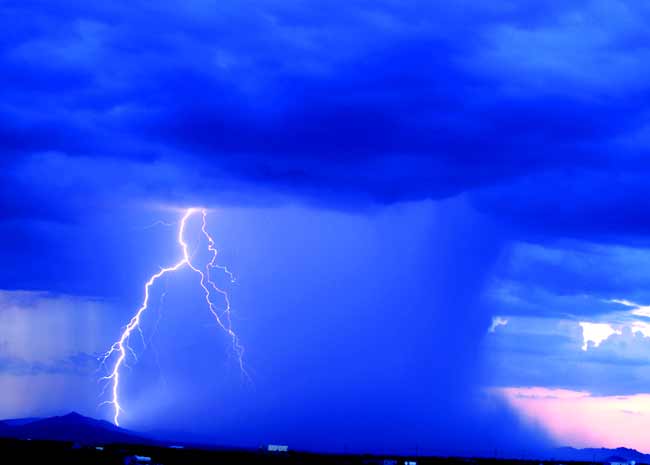The U.S. Monsoon Gets New Respect

The monsoon is one of the least understood weather phenomena in the United States.
Meteorologists have long argued over what to call this weeks-long outbreak of thunderstorms in the Southwest, often settling on the monsoon, which caused confusion because many people don't understand that a single summer thunderstorm is not a monsoon, explained Tony Haffer, a meteorologist with the National Weather Service office in Phoenix.
Monsoon is, instead, a season. That's confusing, too. The word "monsoon" is from the Arabic "mausim," which means season, so to say "monsoon season," as many do, is thought by climatological purists to be redundant.
Whatever, this seasonal shift of the wind, which can bring torrential summer downpours and damaging wind to much of Arizona and New Mexico, gets a new level of respect this year. The monsoon has gained official start and end dates — June 15 and Sept. 30 — a real season that meteorologists hope will put some oomph behind their thunderstorm warnings.
How it works
Serious monsoons occur in India and in much of Mexico. Acapulco averages 51.8 inches of rain during its summer monsoon and just 3.3 inches the rest of the year. The American Southwest is on the fringe of the Mexican monsoon. Much of the year, winds in Arizona blow from the west or northwest. During monsoon, however, they shift to bring moisture from the Gulf of Mexico and the Gulf of California.
Daytime heating causes the moist air to rise, where it condenses and can form violent thunderstorms, whose winds often fuel sky-darkening dust storms that sweep across the dry desert and affect large portion of entire counties.
Sign up for the Live Science daily newsletter now
Get the world’s most fascinating discoveries delivered straight to your inbox.
Phoenix, as an example, gets an average of 2 or 3 inches during the monsoon, or about a third of its paltry annual rainfall. Storms are typically spotty, however, drenching one part of the metropolitan area and knocking down trees while leaving a nearby area dry and calm. By the end of summer, one location might have recorded 4 or 5 inches of rain while another got just a trace.
"The one thing that has been consistent is the lack of uniformity of the monsoon hazards," Haffer said.
The problem
Until the late 1970s, weather experts debated whether the Southwest even had a true monsoon. It was called many things: summer thunderstorm season, Mexican monsoon, Southwest monsoon, and Arizona monsoon.
In 2004, scientists decided it is a true monsoon and that like other major climate patterns, it affects weather across a large area, so now it’s called the North American monsoon.
Until this year, the official start of the monsoon was declared each summer only after three consecutive days with the dew point at 55 degrees or higher. Few but the meteorologists even knew what this meant, and weather experts felt that the whole monsoon concept was confusing to the public. The average start date was July 7 and the average end date was Sept. 13. But in some years, the monsoon had begun as early as June 17 and as late as July 25.
The new setup
So Haffer and his colleagues began a campaign last year to better convey the hazards of the monsoon. Ideas ranged from creating a new "summer thunderstorm season" to setting fixed dates for the monsoon.
Haffer said last year that he "received a few strongly worded responses lauding the idea of dropping the word 'monsoon'" but many people "strongly favored not changing the name." In the end, fixed dates for the monsoon were set, as with the Atlantic hurricane season (which runs from June 1 to November 30). The idea became official during the off-season, so this year's monsoon began on June 15 with no input from Nature.
Finally last week, the monsoon lived up to its promise. Late-night storms struck the entire Phoenix area Thursday and lasted off and on through much of Friday, flooding roads and knocking out power. In the end, Sky Harbor Airport got nearly an inch of rain while other gauges around the valley recorded up to 3 inches. After a day of respite, a torrential downpour Sunday dumped 2.4 inches on Tempe, knocking out power, flooding homes, and shutting down five miles of a major freeway. Whatever you call it, the monsoon is back.
Monsoon Season Rainfall in Phoenix:
Wettest year, 1984: 9.56" Driest year, 1924: 0.35" Average year: 2.77" 2007: 0.74"
Credit: National Weather Service, as measured at Sky Harbor International Airport
Robert is an independent health and science journalist and writer based in Phoenix, Arizona. He is a former editor-in-chief of Live Science with over 20 years of experience as a reporter and editor. He has worked on websites such as Space.com and Tom's Guide, and is a contributor on Medium, covering how we age and how to optimize the mind and body through time. He has a journalism degree from Humboldt State University in California.











